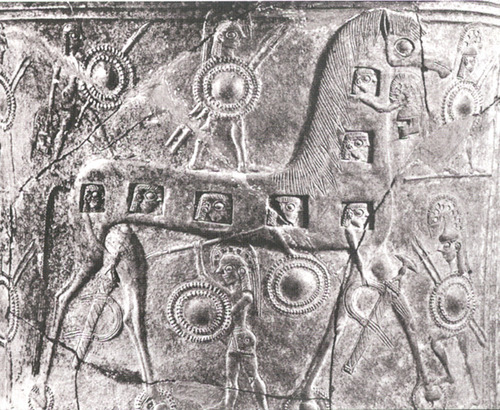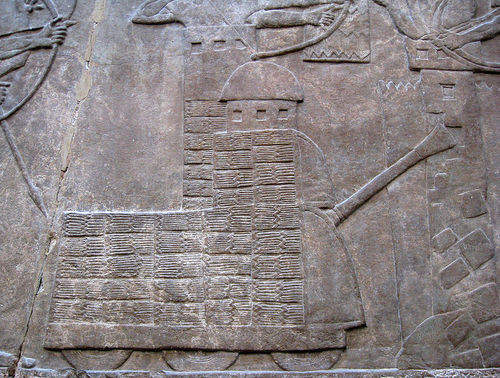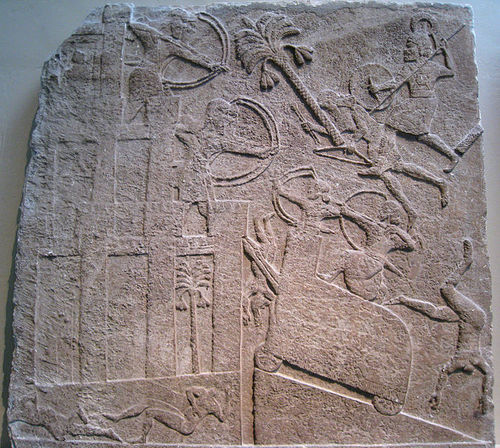Es una de las historias más famosas en el mito griego y posiblemente en todo mito, ¿Cómo lograron derribar la legendaria ciudad de Troya un caballo de madera.

Mencionado por primera vez en la odisea y representaciones de él en la Grecia arcaica que todos muestran la misma cosa, a horse with soldiers hidden within. But was this really the case? It does seem rather fantastical, even by the standards of Greek myth. This cartoon cleverly pokes fun at the concept.
It’s initially Homer who mentions the Trojan Horse in the Odyssey, the Iliad ends way before Troy’s fall. The brief mention of it is the least of the problems, Homer was composing his works 500 years after the myth was set and to entertain. Trying to use Homer as a source is problematic; his work is fact and fiction knitted together. For every detailed athletic event there’s a talking horse nearby.
Detail from neck of Cycladic relief vase, acerca de 675-650 BC – note the people in the ‘windows’
What we are left with is many strands to untangle, stories and depictions which may be as truthful as they are mythical. The challenge is to strip as much of the myth away and see what remains. To start with it’s worth understanding what siege warfare was like in the time of Homer and before.
Early Siege Warfare,
It’s probably not immediately apparent that the Trojan Horse could be a siege engine, but the Greeks were laying siege to Troy. Otra vez, this may not be immediately apparent! Where are the catapults? Homer mentions chariots a plenty, but not a rolling siege tower in sight. What was happening?
In truth siege warfare in both the time of Homer and the date given for the Trojan War (12TH siglo A.C.) was pretty basic at best. Cities would be taken through walls being scaled, duplicity, mining the walls or through the use of battering rams. Though siege towers were used by the Assyrians in the 9TH siglo, catapults weren’t invented till around 399BC (and even then only fired arrows). Options for taking a city were limited.
Siege warfare, even in its use in Roman through to medieval times was far from easy and often the besieger could be in as worse a place as the besieged. Here we can see an example of truth and fiction in the Iliad neatly paired in a situation. The Greeks suffer a great plague at Troy, which is often the experience of besieging armies, however its origins weren’t from Apollo’s bow. Sieges required excellent supply lines, specialist troops and meant you kept a large force in one area (thus making them an easy target for other armies as Caesar found out). Time was also a factor – a siege could take many months.
Even for rich near eastern Kings (who had the resources) this was a huge commitment. For the Greeks, who used part-time soldiers and smaller forces it was near impossible.
Up and Over
The Iliad is probably a good indication of how tricky besieging was – in reality it’s the Greeks who come under siege more than the Trojans and rarely approach the Trojan walls. The initial options were to either scale the wall using ladders or to build up an earthen ramp and storm the walls. It’s probably because of the legendary walls at Troy that neither option is pursued. They wouldn’t be as fantastic if you could stick a ladder up against them. Siege towers were something the Assyrians came to use in the 9TH siglo A.C., but in their infancy these were best for smaller walls and would have required a lot of specialist engineers to use.
There was something that could be used, battering rams. Here’s one below:

An Assyrian ram: North-West Palace at Nimrud, acerca de 865-860 BC
These were heavy units which measured around five metres in length and the main body being 2-3 metres high (a turret housing archers added another three metres). The really interesting thing is that the ram isn’t on a horizontal plane (e.g. swinging parallel to the ground). This might be an aesthetic device and the angle is simply an attempt to represent the wall being attacked, perspective not being something readily adhered to in depictions of this time.
But what if the ram or blades were genuinely upwards and at an angle. I spoke to some engineers about this and it seems that this technique would bear fruit. Walls like this rely heavily on gravity to keep them secure; their stability relies on a downward force. Punching a hole horizontally is hard work and any holes made will simply fill up with debris. If you strike upwards at an angle you target the tensile strength of the wall and in theory could cause more structural damage. Walls were thinner the higher up you went; attacking the base of a wall would therefore require a lot of work. These blades could be used to pry out blocks or (as mentioned above) simply strick at a more effective angle. For once ‘digging up’ made sense.
Rams and ramps worked well together, a ramp could be built first and the ram slowly worked towards the wall. The image below seems to show this.
Assyrian ram (mid 8th century BC)
There are a wide range of possibilities but aside from the ‘what ifs’ there are some things we do know. Battering rams and siege engines were in use (the former more than the latter which were rare) and the knowledge of these must have found its way westwards, to the Greeks.
The Greeks and Siege,
To make my next point it’s important to understand what the Greeks themselves thought of sieges. In short they were very contrary to how the Greeks fought, in Herodotus the Persian commander comments “they go off together to the smoothest and most level bit of ground they can find and have their battle on it”(Hist.7.9) Greeks lacked the armies and the technical knowledge to conduct sieges; it simply wasn’t within their menu of warfare.
Of course sieges are recorded in Greece, in 590BC Kirrha was taken, not by a battering ram, or even by force. Applying hellebore to the town’s water supply saw diarrhoea cripple the inhabitants, allowing the attacking forces to waltz in.
How it might have looked – Babylonian’s storm Niniveh in 612BC
The Peloponnesian Wars of the 5TH century featured sieges, but none too successful: Melos (Thuc.5.114), Mytilene (3.18FF), Leucus (3.94). A pattern soon developed of armies arriving, standing around and losing patience. Even when the siege was successful like Plataea it was a long drawn out process which seemed haphazard at best.
Part of this reason was the Greek preference for encirclement and then simply waiting. This was effective if the city was low of supplies or couldn’t draw its own water, but if it could then the army simply turned into a mass camp-out minus marshmallows.
So even a couple of hundred years after Homer’s work and the depictions of the Trojan Horse the Greeks had little idea of siege weapons and units, they didn’t use them and preferred a style of warfare wasn’t that didn’t favour sieges. In short the Greeks weren’t experts in siege technology and in this knowledge gap stories of fantastic siege machines could take root easily. A large wooden horse – why not?
From the Horse’s Mouth
In the Odyssey the Trojan Horse appears in a story by Menelaus (4.277FF). Menelaus’ story is very interesting for two reasons: his description of the horse and the theme he unravels.
The description firmly places the Horse in its traditional form, with himself, Odysseus and others waiting within. It would be easy to think that this description is exactly how the Trojan Horse looked and in Homer’s mind this certainly the case. Sin embargo, it’s worth thinking past this and considering what Homer was doing, namely entertaining. It could be argued that he took the idea of a siege engine set it within the scope of a narrative technique he often used – victory by stealth.
Victory by stealth isn’t unusual in Homer; the Iliad contains the infamous night raid (10.240FF). In the Odyssey it’s also a motif, from escaping Cyclops to avenging suitors. Stealth and cunning against a superior adversary are not only favoured, they are given heroic ‘weight’.
Menelaus’ story is of further interest because just prior to it Helen pitches in with her own tale (4.244FF). Helen describes how a disguised Odysseus slipped into Troy and gathered vital information (slaying many a Trojan on his exit). This yarn anticipates the wooden horse and mimics its structure very closely (disguise-infiltration-action).
http://hehasawifeyouknow.tumblr.com







